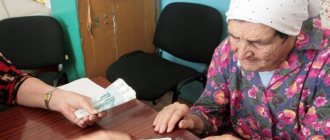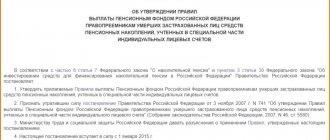- home
- Reference
- Experience
Many pensioners are concerned about the question of whether they are entitled to an additional payment or bonus for Soviet experience. Soviet experience refers to a certain period of employment that occurred during the Soviet and post-Soviet times.
When registering and assigning a pension, the total length of service, including that in the USSR, is taken into account. In the article we will tell you which periods of work are included in the Soviet period of service and how bonuses are calculated for it when taking into account future pension funds, as well as how to make the calculation using an example.
What is Soviet experience?
When applying for pension payments, Pension Fund employees take into account their entire length of service, which can be divided into four stages :
- labor activity that was carried out before 1991 and is confirmed only by documents;
- from 1991 to 2001 it is taken into account when valorizing funds;
- from 2002 to 2014 - all information on salaries and insurance contributions is recorded electronically;
- work activity from 2015 to the present - the process of accruing pension points is being introduced.
For each period, special formulas and nuances are used when calculating future pensions. Work activities carried out during the Soviet era are of great importance in the final calculation and calculation of pension payments.
When calculating pensions for Soviet times, the following periods of work worked before 01/01/1992 are included :
- work under a contract, as well as on collective farms;
- activities in Komsomol and party services;
- military service, as well as service in law enforcement agencies;
- secondary specialized and higher education;
- caring for a disabled person of the first group who has become disabled as a result of a service injury or military service.
From 1992 to 2001, in addition to the above, additional periods are taken into account:
- individual work activity, including agricultural;
- work in the creative field;
- the time spent on disability of the first or second group, if the disability occurred as a result of a work-related injury;
- time to care for a disabled person (disabled or elderly);
- child care up to three years of age;
- the time military wives live in hard-to-reach areas where there is no opportunity to find work.
Pension payments to collective farmers
Currently, there is a misconception that in Soviet times, collective farmers did not receive pension contributions.
In reality, pensions were paid to all categories of citizens of the country, but from different financial sources. Thus, collective farmers received pensions from artels, which created their own fund for making pension payments.
Recommended reading: How many pensioners are there in Russia?
The created fund was supposed to pay for the pension in the form of cash payments, food products, or additional workdays were accrued. The amount of pension payments was established separately for each collective farmer at a general meeting of artel members or at a meeting of authorized persons.
It is important to know! Pension in Uzbekistan
Let's highlight the main features:
- age 60 and 65 years (women and men, respectively);
- experience - from 20 years;
- minimum pension indicators - 12 rubles;
- maximum criteria – 102 rubles;
- the pension amount was calculated from half the salary for the last 2 years of work or for any 5 years of work activity;
- citizens of retirement age could continue working if they wished;
- The following were entitled to additional benefits and increases: pregnant women;
- ladies caring for a child under 3 years old;
- persons with dependents in their care;
- disabled people.
Disabled war veterans could receive additional payments from the state budget!
In 1964, when the bill on granting pensions to collective farm members came into force, payments began to be made from the state budget. However, collective farms, at their discretion, could retain pension payments from their own budget.
Is there additional payment for years of work in the USSR?
Work carried out in the USSR is also subject to consideration when calculating a future pension. However, the additional payment is not due to all citizens who worked during the USSR, but only to those who have documentary evidence of official activity.
Reference! The bonus for Soviet experience is only due when applying for a pension for old age, disability or loss of a breadwinner. When applying for social pensions, the supplement is not taken into account.
When processing additional payments, work activities that were carried out during Soviet times, that is, before 1991 and post-Soviet times until January 1, 2002, are taken into account.
Who is entitled to what kind of bonus?
The special indexation of pension payments taking into account Soviet and post-Soviet work experience is called valorization. The increase for length of service (work activity before 01/01/2002 is taken into account) occurs automatically. Pension Fund employees independently calculate the required percentage increases. You can find out more information about the required additional payment at the Pension Fund branch at the pensioner’s place of residence.
Have the right to an increase:
- recipients of old-age insurance pensions;
- disabled people receiving pension payments;
- persons receiving survivor benefits.
In order for the pension to be recalculated, it is necessary to provide documents to the Pension Fund confirming length of service in the USSR or after its collapse, but no later than 01/01/2002. The amount of the supplement depends on the total length of service and is not the same for all pensioners.
If a pensioner has USSR-era experience developed before 2002, accrual will occur in the amount of 10% of the total amount of pension capital. For each full year worked (until 2002), the Pension Fund adds one percent.
How much was the minimum pension?
The minimum pension in the USSR was 35 rubles.
A pension in this amount was paid to the following categories of elderly people:
- non-working persons;
- not having more than 20 years of experience;
- collective farmers - the majority of residents of rural settlements continued to work when they reached retirement age in order to receive an additional payment to their pension of 10 rubles for each year of work. The amount of allowances could be no more than 40 rubles.
In 1986, the minimum size was raised to 76 rubles!
In fact, a quarter of the elderly people in the USSR received minimum pension contributions.
It is important to know! Recalculation of pension after dismissal
How to calculate the premium amount
When calculating the allowance, Pension Fund employees use special formulas. The following indicators are taken into account when calculating the surcharge :
- length of experience;
- the ratio of wages in the Soviet period to the national average;
- valorization;
- pension point value;
- indexation coefficient;
- the presence of rights for a pensioner that establish additional allowances.
Important! All years worked must be proven by entries from the work book or in another way. If the work record is lost, you can request a certificate from the place of work where the person worked during the USSR.
Example
Citizen Petrova Valentina decided to retire in 2021. Valentina has 35 years of total work experience, of which 10 years were during the Soviet era. Valentina's salary was 320 rubles, which significantly exceeds the average salary for Soviet times.
To establish an additional payment, it is necessary to establish the proportion between Valentina’s salary and the average salary in the USSR. When subtracting the proportion, the figure was set to 1.2.
You also need to derive the experience coefficient, which in the case of Valentina will be 0.70. Next, you need to multiply the length of service coefficient by the earnings ratio. Multiply the resulting amount by 1,671 rubles (average monthly salary as of January 1, 2002). The total amount will be 1223.17 rubles.
450 rubles must be subtracted from the amount received (old-age labor pension as of January 1, 2002). The total will be 773.17 rubles. This amount is not final. Now you need to calculate taking into account valorization, which is 10% + 1% for each year worked.
Since Petrova Valentina worked for 10 years, her valorization was 20%. Thus, taking into account 20%, the new amount is 927.80 rubles. The resulting amount is multiplied by 5.6148 (indexation coefficient) and divided by the pension point value. As of 2021, the value of one pension point is 81.49 rubles. Thus, the final calculation will result in a monetary amount equal to 5022.83 rubles. This is exactly how much the surcharge will be.
Calculation features
Length of service accumulated before 2002 is an advantage that affects the amount of pension payments. The threshold of work experience before 2002 for women is 20 years , and for men - 25 years . When recalculating, each year exceeding the specified standards is taken into account.
The interest supplement for this period is calculated based on the pension capital.
Application of the experience coefficient
Pension payments are calculated taking into account the length of service coefficient , which at a threshold of 20 and 25 years for female and male workers, respectively, is 0.55 . Its maximum value is 0.75 .
If you have length of service that is below the established age limits, the indicator will decrease in proportion to the years worked. For example, a woman’s work experience before 2002 was 17 years. The coefficient in this case is calculated as follows: 0.55/20 x 17 = 0.47.
If the length of Soviet service exceeds the established standards, then, for example, for a man who worked 28 years before 2002, the service coefficient will be equal to: 0.55/25 = 0.62.
Increase for Soviet experience
According to the Decree of the President of the Russian Federation, all pensioners whose labor activity occurred in 1991-2001, since 2002, have been accrued by default a supplement to their pension capital in the amount of 10%. The length of service in this case does not matter.
In addition, if there are documents confirming official employment before 1991, pension accruals are made with the addition of 1% for each working year. If, for example, a citizen worked 6 full years before 1991, then the pension will be increased by 6%.
Calculation example
The citizen’s labor activity began in 1987. Until 2002, his work experience was 14 years, of which 4 years were during the USSR period.
Additional payments to pensions for the pre-reform period will be calculated taking into account the following indicators:
- average monthly salary for 2000-2001. — 1600 rub.;
- level of average earnings in the country for 2000-2001. — 1495 rub.;
- maximum coefficient - 1600 / 1495 = 1.1
- length of service coefficient - 0.55 / 25 x 15 = 0.31;
- average salary in the Russian Federation for the 3rd quarter. 2001 - 1697 rub.
Based on the data obtained, the size of the calculated pension of the Republic of Poland for 2001 is determined: 0.31 x 1.1 x 1697 = 579 rubles.
For subsequent calculations, the following all-Russian indicators are used for 2000-2001:
- the basic part of the pension payments of BP is 450 rubles;
- minimum MP pension - 660 rubles;
- The survival period for diabetes is 228 days.
If, when calculating the RP for 2001, its size was less than 660 rubles, in this case 579 rubles, then the amount of the SV insurance payment will be calculated using the formula MP - BP = 210 rubles.
The estimated pension capital of the RPK (210 x SD) is 47,880 rubles. On its basis, the bonus for length of service worked before 2002 is determined.
Then the part of the insurance pension earned during the Soviet period is calculated using the correction factor in force from 2002 to 2014: 5.6148 x SV = 1179.11. This result is divided by the cost of one point, set for 2015 at 64.1. The result is 18.39 points.
In 2021, when recalculating the Soviet pension, the following values are used:
- indexation coefficient – 1.066;
- the cost of one point in 2021 is 98.86 rubles.
The size of the allowance for the Soviet period is calculated as follows:
- valorization indexation: 0.1 + 1.066 x 0.04 = 0.14;
- valorization amount: (0.14 x 47880) / SD x 5.6418 = 165.86 rubles;
- conversion to points: 165.86 / 64.1 = 2.59;
- number of points taking into account indexation: 18.39 + 2.59 = 20.98;
- amount of pension increase in 2021 due to Soviet experience: 20.98 x 98.86 rubles. = 2,074.08 rub.










